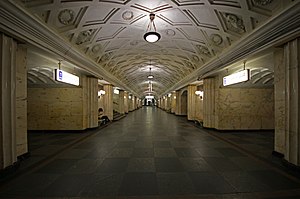Teatralnaya (Moscow Metro)
Teatralnaya (Russian: Театра́льная) is an underground metro station on the Zamoskvoretskaya Line of the Moscow Metro, named for the nearby Teatralnaya Square, the location of numerous theaters, including the famed Bolshoi Theatre. The station is unique in that it does not have its own entrance halls. The north escalator leads to Okhotniy Ryad and the south escalator to Ploshchad Revolyutsii.
History
Teatralnaya Station was opened on September 11, 1938 as part of the second stage of construction of the Moscow Metro system. It was the terminal station of the Zamoskvoretskaya Line until the line was extended on January 1, 1943. Teatralnaya's architect was Ivan Fomin. The station is located at a depth of 33.9 meters. The central hall has a diameter of 9.5 meters, with an 8.5 meter lateral lining of cast-iron tubing. It was originally named Ploshchad Sverdlova, and was only given its present name in 1990.
Decoration
Teatralnaya Station has fluted pylons faced with labradorite and white marble taken from the demolished Cathedral of Christ the Saviour. Crystal lamps in bronze frames attached to the center of the room give the central hall a festive appearance. The vault of the central hall is decorated with caissons and majolica bas-reliefs by Natyla Danko on the theme of theatre arts of the USSR, manufactured by Leningrad Porcelain Factory. These bas-reliefs are a series of fourteen different figures, each representing music and dance from various nationalities of the Soviet Union. Seven male and seven female figures attired in their national costumes are either performing an ethnic dance or are playing a distinctively ethnic musical instrument. The series included Armenia, Byelorussia, Georgia, Kazakhstan, Russia, Ukraine and Uzbekistan. Each figure is reproduced four times for a total of 56 figures.[1] Initially, the floor was of black-and-yellow granite patterned as a chessboard; however in 1970, the yellow panels were replaced with gray.
A bust of Yakov Sverdlov, for whom the station was originally named, was located at the end of the platform opposite the escalators. Only the base remains today. A bust of Vladimir Lenin was however, preserved.
Transfers
From this station it is possible to transfer to Okhotniy Ryad on the Sokolnicheskaya Line and Ploshchad Revolyutsii on the Arbatsko-Pokrovskaya Line.
Gallery
-
Platform
-
Pylon
-
The connection with Okhotny Ryad served by the Sokolnicheskaya Line
Notes
- ^ O'Mahony, Mike. Sport in the USSR. Page 119
References
- O'Mahony, Mike. Sport in the USSR: physical culture - visual culture. Reaktion Books (2006) ISBN 1-86189-267-5






